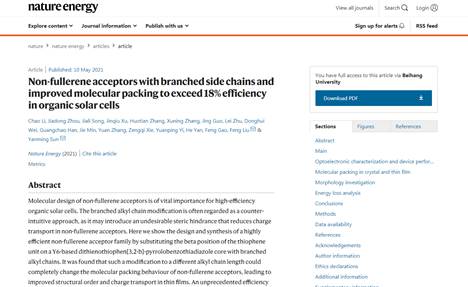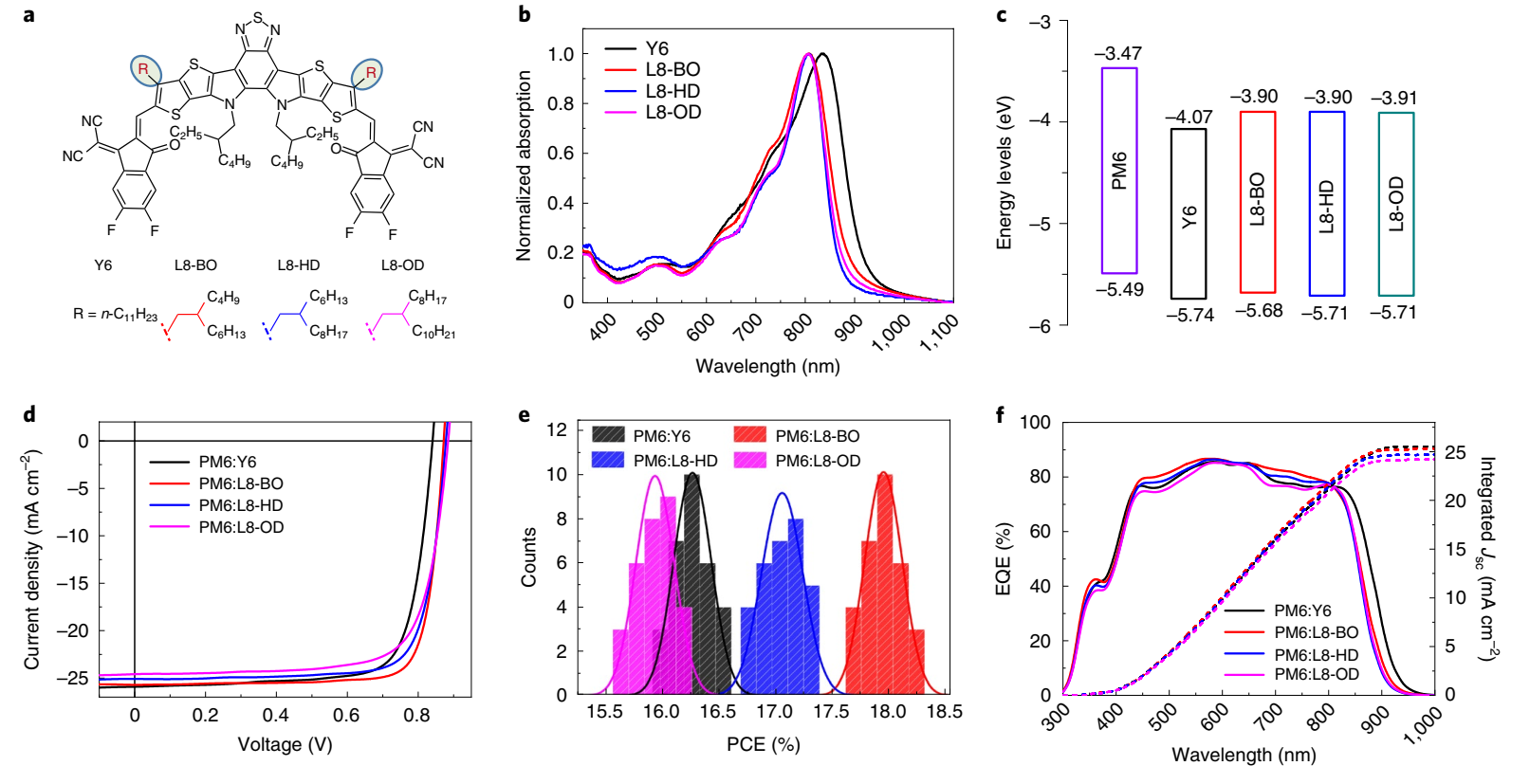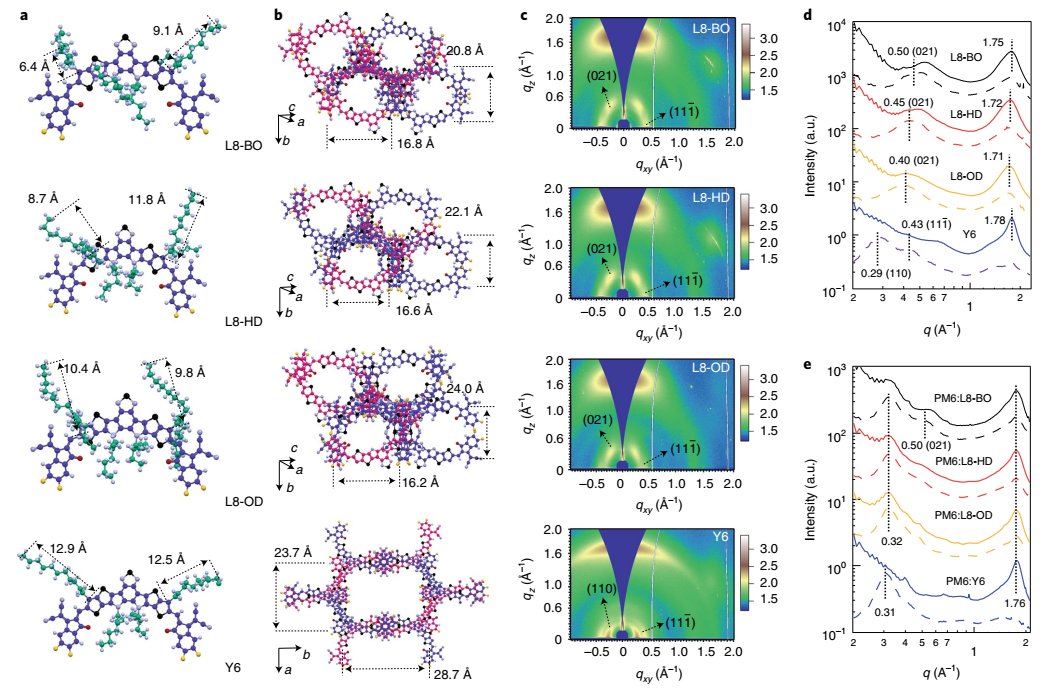On May 10, “Non-fullerene acceptors with branched side chains and improved molecular packing to exceed 18% efficiency in organic solar cells,” the latest research results in the field of organic solar cells by two research groups led by Professor Sun Yanming from the School of Chemistry of Beihang University and Professor Liu Feng from Shanghai Jiao Tong University respectively, was published in Nature Energy. Doctor Li Chao from Beihang University and Dr. Zhou Jiadong from South China University of Technology are the first authors, Professor Sun Yanming and Professor Liu Feng are the correspondent authors, and the School of Chemistry of Beihang University is the first completion unit.

As a new type of clean and pollution-free photovoltaic technology, organic solar cells have the advantages of low cost, light weight, flexibility and solution processing, etc., and have received extensive attention from scientific research and industry circles. In this work, the researchers adopted side-chain modification as a design strategy to optimize the intermolecular packing of non-fullerene acceptors, leading to improved structural order and charge transport in thin films. An unprecedented efficiency of 18.32% (certified value of 17.9%) with a low Eloss of 0.55 eV and a fill factor of 81.5% was achieved for single-junction organic solar cells.
The research group initiated a systematic effort to search for NFA materials with superior electronic properties in solids. They utilized the electronic structure of a Y6 backbone due to its high photovoltaic performance. Side-chain modification was taken as a design strategy that benefits from Y6 physical properties that can be retained and intermolecular packing that can be manipulated. Different aliphatic chains were introduced at various positions on the Y6 backbone to maximize the possibilities, shifting from the pyrrole site to the thiophene beta position. A series of NFAs, L8-R (with R being the alkyl chain), were developed.

Fig. 1 Molecular structures, photophysical properties and photovoltaic properties
The researchers found that the Y6 single crystal exhibits two π–π packing forms. By contrast, the L8-BO single crystal exhibits three π–π packing motifs, which can provide more charge-hopping channels. The thin-film crystalline feature of L8-R neat films was studied using the GIWAXS technique. In a two-dimensional GIWAXS pattern, a strong scattering intensity along the out-of-plane (qz) direction was seen in L8-R neat films, stronger than that in the Y6 neat film after signal normalization. The L8-R in the single crystal showed closer π-π stacking than in thin films, indicating the influence of processing on molecular self-assembly. Compared with Y6, the L8-BO neat thin film featured a broad π–π stacking peak, with a smaller crystal coherence length, which can be caused by paracrystalline disorder in the film.

Fig. 2 Single-crystal structures and molecular packing properties of NFAs
To confirm the reliability of device performance, the best PM6:L8-BO device was sent to the National Institute of Metrology, China, for certification. A certified efficiency of 17.9% was achieved. In addition, a PCE of 18.22% was independently verified by a third-party research group. It was noted that the PM6:L8-BO device exhibited excellent stability under a nitrogen atmosphere.
The research was supported by Professor Liu Feng of Shanghai Jiaotong University, Professor Jie Zengqi of South China University of Technology, Professor Gao Feng of Linköping University of Sweden, Researcher Min Jie of Wuhan University, Associate Professor Wei Donghui of Zhengzhou University, Researcher Yi Yuanping of Institute of Chemistry of Chinese Academy of Sciences, and Professor Yan He of Hong Kong University of Science and Technology. The research work was also financially supported by the National Natural Science Foundation of China, the 111 Projec, Beijing National Laboratory for Molecular Sciences, etc.
The link to the article is:
https://www.nature.com/articles/s41560-021-00820-x
Reported by Sun Yanming
Reviewed by Li Hongjie
Edited by Jia Aiping and Wen Peiyu
Translated by Wen Peiyu

